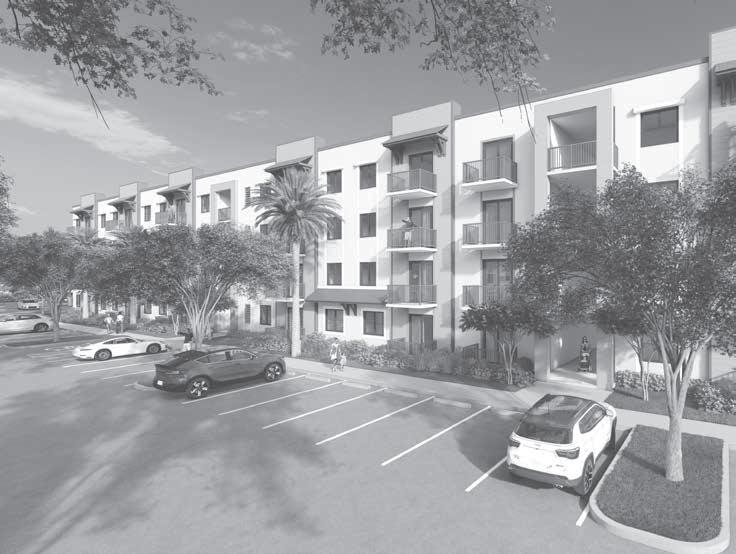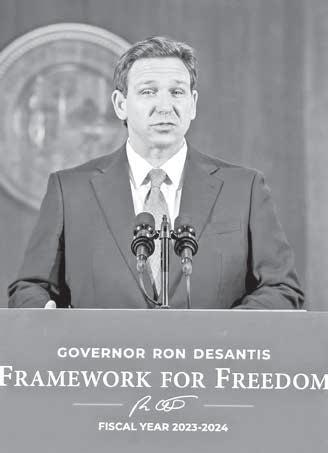
7 minute read
NEW HOMES FOR THE KEYS WORKFORCE?
Development group set to construct 300-plus apartments in Florida City
JIM McCARTHY jim@keysweekly.com
to serve moderate-income residents in Monroe County. Funds would come from the State Housing Trust Fund for the State Apartment Incentive Loan program, or SAIL, which provides lowinterest loans on a competitive basis to affordable housing developers each year. Developments in the Florida Keys can use 100 percent of the units for residents with annual household incomes below 120 percent of the state or local median income, whichever is higher.
DeSantis’ budget also includes $7.5 million for the College of the Florida Keys’ operating expenses.
Statewide, the governor proposes a $200-million increase in teacher salaries and $30 million to fund a second round of recruitment bonus payments for law enforcement officers who are new to the profession or relocating from other states. DeSantis is also requesting a base rate hike for correctional officers to $23 per hour.

Permanent sales tax exemptions are also proposed within the governor’s budget for baby and toddler necessities, cribs and strollers and over-the-counter pet medications.
“Florida will fight against federal headwinds by putting forth sound fiscal policies that keep more money in the pockets of Floridians,” DeSantis said.
The Florida Keys is longing for more affordable housing, and it appears the upper island chain is getting some help from a project near the 18-Mile Stretch in Florida City.
Coral Gables-based Coral Rock Development Group recently unveiled plans to develop 13 acres of property located outside the Florida Keys into 300-plus residential apartments.
Known as the Card Sound Key Apartments, the workforce and market-rate rental housing project will be developed on vacant land on the westside of U.S. 1 where it merges with Krome Avenue and splits off to Card Sound Road.
According to Coral Rock Development Group, 342 residential rental units will include one-, two- and threebedroom options. With six four-story buildings, 20% of the units will be dedicated to workforce housing and 80% will be used as market-rate rentals. Amenities will include a Vita Course circulating the property with several workout stations, a pool, barbecue area, spacious two-story clubhouse, dog park, children’s playground and pickleball court.
Coral Rock Development Group said the site will serve three submarkets in south Miami-Dade, the gated
Ocean Reef community and the northern Florida Keys.
“We’re very pleased to unveil our plans for Card Sound Key Apartments. As the closest apartment development to Ocean Reef Club where there are 1,200 employees commuting daily, coupled with a severe housing shortage in the northern Keys and south Dade, this multifamily project will add much needed high-quality housing to the community,” said Michael Wohl, principal of Coral Rock Development Group.
Development plans for Card Sound Key Apartments were unanimously approved by the Florida City Commission in early January.
"This is particularly meaningful since most of the workforce for the Florida Keys travel to Florida City," said Florida City Mayor Otis T. Wallace.
With a project close to the Keys, Key Largo Chamber of Commerce President Elizabeth Moscynski said a worker’s ride won’t be as tedious as it is coming from Cutler Bay or Miami.
“It helps Publix, bigger stores and smaller stores,” she said. “A lot of people want to live in the Keys, but it’s hard to afford it. The project will benefit Key Largo, especially with the fact we don’t have much affordable housing here.” days, with Dituri as a test subject.
A groundbreaking is set for early 2024 with completion scheduled for early 2025.
Following his retirement from the U.S. Navy, Dituri earned his doctorate in biomedical engineering. With the realization that, every day, an average of 22 of his fellow servicemen died by suicide, Dituri studied hyperbaric oxygen therapy, the medical use of oxygenated air at an elevated pressure to increase blood flow and oxygen levels throughout the body and accelerate healing, with the goal of treating traumatic brain injury (TBI) in veterans.

After his own TBI in a car accident in 2021, Dituri has focused on a three-pronged approach to treating TBI: physiological, physical and psychological. This approach emphasizes not only hyperbaric oxygen therapy, but also simultaneously healing bodily pain associated with the TBI event and cognitive behavioral therapy.
While in Jules’ Undersea Lodge, Dituri will conduct a series of tests as part of his research on TBI. Before, during and after the 100 days, he will take stem cell collections, an electroencephalogram to measure electrical activity in the brain, methylation and cytokine blood panels that provide insight into nutritional support needs and inflammatory response, and psychological and psychosocial exams, all to understand what happens to the body during 100 days under pressure.
With guests from organizations like the Defense POW/MIA Accounting, Dituri plans to bring awareness to the impact of PTSD and TBI on veterans, and his research on healing these injuries.
“I'm all about healing under pressure, and it's not just healing the wounds, it's healing the soul. It's talking with people about the problems,” Dituri said. “It's talking about bringing the loved ones back that we lost, and healing those people that are still here, that are left behind. We want to repatriate that person, that service member, and heal those people. So, it's healing in a lot of different ways, but healing with pressure, that's what we are all about.”
Other studies include vision tests to detect any changes after living in a confined space and experiments from other researchers to be tested at depth, including a study created by Dituri’s colleague Michael Cross with implications for growing meat in a lab. The applications for many of these experiments tie to exploration in a different extreme environment: space.
“You're going to put people in a tin can and let them stay for 200 days while they transit from here to get to Mars. Six months. ... You have to figure out how to live in a tin can. Why don't we try living in this tin can underwater first?” Dituri said.
Taking Out The Trash
Debris derby nets 13,000 pounds
As with space travel, the logistics and safety requirements of this mission to an extreme environment are pressing. The logistics are proving the most complicated, as Milhoan must arrange the delivery of cameras, phones, microphones, computer equipment, food and laundry to the habitat with a constant turnover of visitors.
The habitat, which was originally developed by Ian Koblick as La Chalupa research laboratory until he refurbished it into Jules’ Undersea Lodge, has functioned in the lagoon for over three decades. According to Koblick and Milhoan, the design leaves little concern in terms of safety. It is a positive pressure environment, meaning the pressure inside is greater than the surrounding pressure. Like an upsidedown cup placed in a tub of water, the habitat can only flood as fast as air escapes, so flooding the habitat is nearly impossible. From previous experience, Milhoan knows that Dituri could last several days without additional oxygen and, because the habitat sits at 30 feet, decompression is not needed during ascent. Milhoan will monitor the habitat from an on-surface command van with webcams, intercoms, a pressure regulator, a high-water alarm and more.
Dituri, too, is confident and ready to take on the challenge.
“There’s no apprehension. I'm not pensive at all,” Dituri said. “I'm ready to get this thing done. I'm ready to increase awareness of the marine environment. I'm ready to rejuvenate that hope that we have in exploration and science, technology, engineering and math.”
Students from Ocean Studies Charter School and the local community at large participated in the third annual Marine Debris Derby on Jan. 28.
Student and family volunteers sponsored by local organizations collected trash on the shoreline, from kayaks and from boats in order to compete for prizes in several categories and raise money for Ocean Studies’ marine science program. They met at the Caribbean Club in Key Largo to count their trash and celebrate their community service.
In total, 108 young volunteers from Ocean Studies and other local schools collected over 13,000 pounds of plastic waste and debris. In doing so they raised thousands of dollars for Ocean Studies’ marine education program.
The celebration at the Caribbean Club included competitions for different divisions and categories. In the Shoreline Division, Savannah Williams and Aubrey Williams collected the most trash, each bringing in 393 pounds of waste. The winners of the kayak division were Alex Rudolph, Hans Neill and Walker Absten, bringing in 50 pounds of waste collected from kayaks. For the team division, the “Dolphin Team” won, contributing 477 pounds. Their prizes included sailing trips, Everglades tours and fishing trips. Also included in the festival was live music from local musician Micah Gardner, a trivia competition, and catering from A Moveable Feast.
The event started in 2021, and was inspired by the monthly cleanups Ariel Poholek and his son and former Ocean Studies student Pascal Weisberger hosted at the K-8 school. With the idea of getting the school community more involved with cleanup efforts, Poholek “looked into how you could do a cleanup as a fundraiser.” Ocean Studies eventually decided on making an annual cleanup event that functioned as a fundraiser for their school’s science program through sponsorships of individual teams and participants, in which the school was rewarded by how much trash it picked up.

Ocean Studies, as a K-8 school with a specific focus on marine science, finds importance in educating its students about the dangers of environmental pollution.
“Our mission is to teach kids about the environment of the Keys and what's happening in our local environment with plastics and the changes we need to make,” said Trisha Woods, the principal at Ocean Studies. “It’s good to show kids how much trash is out there and the changes we can make when we clean up.”


Key West, 1825 Dear Mother,
This goes in a box of shells, which I bought from a New Providence vessel. They are curious, and beautiful, and intended to be divided among all my Brothers and Sisters, as they may think proper. The numbers of shells will allow them to make presents of a part to their friends. I have another box containing Marine production collected on this island, which I shall send you.
I send you also a cask of wine said to be Marseilles though, I think light Port mixes with water, it is very pleasant to drink, and we use it here at Breakfast and Supper in that way. I think you would find good for you giving strength to the stomach and system. It must be kept secure from the air, else it will soon become sower.
This wine, with a quantity of Flour, Butter, Lard, Rice & c was taken from the pirates on the coast of Cuba by the U.S. Galliot, Seagull and Brittish Schooner Union and Leon.






